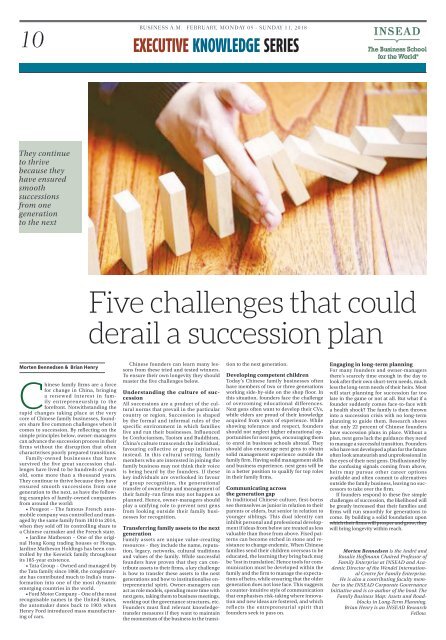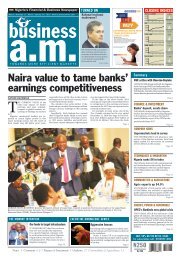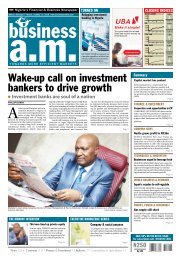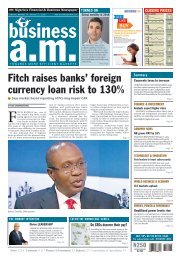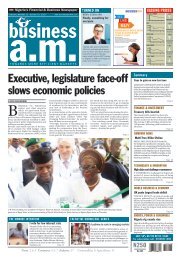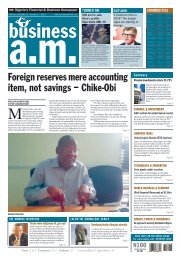Create successful ePaper yourself
Turn your PDF publications into a flip-book with our unique Google optimized e-Paper software.
10<br />
BUSINESS A.M. FEBRUARY, MONDAY <strong>05</strong> - SUNDAY 11, 20<strong>18</strong><br />
EXECUTIVE KNOWLEDGE SERIES<br />
They continue<br />
to thrive<br />
because they<br />
have ensured<br />
smooth<br />
successions<br />
from one<br />
generation<br />
to the next<br />
Five challenges that could<br />
derail a succession plan<br />
Morten Bennedsen & Brian Henry<br />
Chinese family firms are a force<br />
for change in China, bringing<br />
a renewed interest in family<br />
entrepreneurship to the<br />
forefront. Notwithstanding the<br />
rapid changes taking place at the very<br />
core of Chinese family businesses, founders<br />
share five common challenges when it<br />
comes to succession. By reflecting on the<br />
simple principles below, owner-managers<br />
can advance the succession process in their<br />
firms without the disruption that often<br />
characterises poorly prepared transitions.<br />
Family-owned businesses that have<br />
survived the five great succession challenges<br />
have lived to be hundreds of years<br />
old, some more than a thousand years.<br />
They continue to thrive because they have<br />
ensured smooth successions from one<br />
generation to the next, as have the following<br />
examples of family-owned companies<br />
from around the world:<br />
• Peugeot – The famous French automobile<br />
company was controlled and managed<br />
by the same family from <strong>18</strong>10 to 2014,<br />
when they sold off its controlling share to<br />
a Chinese carmaker and the French state.<br />
• Jardine Matheson – One of the original<br />
Hong Kong trading houses or Hongs,<br />
Jardine Matheson Holdings has been controlled<br />
by the Keswick family throughout<br />
its <strong>18</strong>5-year existence.<br />
• Tata Group – Owned and managed by<br />
the Tata family since <strong>18</strong>68, the conglomerate<br />
has contributed much to India’s transformation<br />
into one of the most dynamic<br />
emerging countries in the world.<br />
• Ford Motor Company – One of the most<br />
recognisable names in the United States,<br />
the automaker dates back to 1903 when<br />
Henry Ford introduced mass manufacturing<br />
of cars.<br />
Chinese founders can learn many lessons<br />
from these tried and tested winners.<br />
To ensure their own longevity they should<br />
master the five challenges below.<br />
Understanding the culture of succession<br />
All successions are a product of the cultural<br />
norms that prevail in the particular<br />
country or region. Succession is shaped<br />
by the formal and informal rules of the<br />
specific environment in which families<br />
live and run their businesses. Influenced<br />
by Confucianism, Taoism and Buddhism,<br />
China’s culture transcends the individual,<br />
favouring collective or group initiatives<br />
instead. In this cultural setting, family<br />
members who are interested in joining the<br />
family business may not think their voice<br />
is being heard by the founders. If these<br />
key individuals are overlooked in favour<br />
of group recognition, the generational<br />
transfer of ownership and management of<br />
their family-run firms may not happen as<br />
planned. Hence, owner-managers should<br />
play a unifying role to prevent next gens<br />
from looking outside their family businesses<br />
for recognition.<br />
Transferring family assets to the next<br />
generation<br />
Family assets are unique value-creating<br />
resources – they include the name, reputation,<br />
legacy, networks, cultural traditions<br />
and values of the family. While successful<br />
founders have proven that they can contribute<br />
assets to their firms, a key challenge<br />
is how to transfer these assets to the next<br />
generations and how to institutionalise entrepreneurial<br />
spirit. Owner-managers can<br />
act as role models, spending more time with<br />
next gens, taking them to business meetings,<br />
working out the governance structures, etc.<br />
Founders must find relevant knowledgetransfer<br />
measures if they want to maintain<br />
the momentum of the business in the transition<br />
to the next generation.<br />
Developing competent children<br />
Today’s Chinese family businesses often<br />
have members of two or three generations<br />
working side-by-side on the shop floor. In<br />
this situation, founders face the challenge<br />
of overcoming educational differences.<br />
Next gens often want to develop their CVs,<br />
while elders are proud of their knowledge<br />
acquired from years of experience. While<br />
showing tolerance and respect, founders<br />
should not neglect higher educational opportunities<br />
for next gens, encouraging them<br />
to enrol in business schools abroad. They<br />
should also encourage next gens to obtain<br />
solid management experience outside the<br />
family firm. Having solid management skills<br />
and business experience, next gens will be<br />
in a better position to qualify for top roles<br />
in their family firms.<br />
Communicating across<br />
the generation gap<br />
In traditional Chinese culture, first-borns<br />
see themselves as junior in relation to their<br />
parents or elders, but senior in relation to<br />
younger siblings. This dual identity can<br />
inhibit personal and professional development<br />
if ideas from below are treated as less<br />
valuable than those from above. Fixed patterns<br />
can become etched in stone and resistance<br />
to change endemic. When Chinese<br />
families send their children overseas to be<br />
educated, the learning they bring back may<br />
be ‘lost in translation’. Hence tools for communication<br />
must be developed within the<br />
family and the firm to manage the expectations<br />
of heirs, while ensuring that the older<br />
generation does not lose face. This suggests<br />
a counter-intuitive style of communication<br />
that emphasises risk-taking where innovation<br />
and new ideas are fostered, and which<br />
reflects the entrepreneurial spirit that<br />
founders seek to pass on.<br />
Engaging in long-term planning<br />
For many founders and owner-managers<br />
there’s scarcely time enough in the day to<br />
look after their own short-term needs, much<br />
less the long-term needs of their heirs. Most<br />
will start planning for succession far too<br />
late in the game or not at all. But what if a<br />
founder suddenly comes face-to-face with<br />
a health shock? The family is then thrown<br />
into a succession crisis with no long-term<br />
planning to guide them. Research shows<br />
that only 22 percent of Chinese founders<br />
have succession plans in place. Without a<br />
plan, next gens lack the guidance they need<br />
to manage a successful transition. Founders<br />
who have not developed a plan for the future<br />
often look amateurish and unprofessional in<br />
the eyes of their next gens. Disillusioned by<br />
the confusing signals coming from above,<br />
heirs may pursue other career options<br />
available and often commit to alternatives<br />
outside the family business, leaving no successors<br />
to take over the firm.<br />
If founders respond to these five simple<br />
challenges of succession, the likelihood will<br />
be greatly increased that their families and<br />
firms will run smoothly for generations to<br />
come. By building a solid foundation upon<br />
which their firms will prosper and grow, they<br />
will bring longevity within reach.<br />
Morten Bennedsen is the André and<br />
Rosalie Hoffmann Chaired Professor of<br />
Family Enterprise at INSEAD and Academic<br />
Director of the Wendel International<br />
Centre for Family Enterprise.<br />
He is also a contributing faculty member<br />
to the INSEAD Corporate Governance<br />
Initiative and is co-author of the book The<br />
Family Business Map: Assets and Roadblocks<br />
in Long-Term Planning.<br />
Brian Henry is an INSEAD Research<br />
Fellow.


